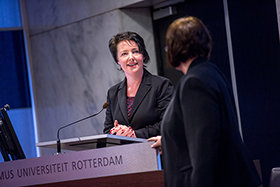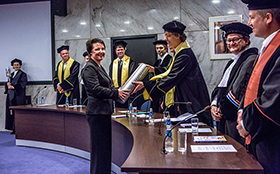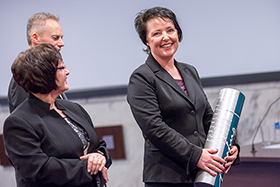PhD Defence: Measuring Meaningful Differences
Sensory research provides input for many important business decisions throughout the whole product development cycle, for example for deciding whether or not to launch new products, change existing products, or invest in new technologies. In her PhD dissertation entitled ‘<link doctoral-programme phd-in-management phd-projects detail>Measuring Meaningful Differences’, Danielle van Hout applies signal detection theory and Thurstonian modelling to product development tests.
 Sensory tests often take place during early stages of product development, long before the products reach the market. This makes decisions challenging, because at that stage there are no direct measures of success (such as sales data) available to determine the consumer relevance of the identified sensory differences. A second challenge is that sensory test results are typically used on a test by test basis, because with the conventional statistical data analysis methods results are method specific and therefore difficult to compare from one test to another. The statistical data analysis, which compares the test results with the chance of guessing correct, determines whether differences are significant, but cannot explain why some tests detect differences more easily than others.
Sensory tests often take place during early stages of product development, long before the products reach the market. This makes decisions challenging, because at that stage there are no direct measures of success (such as sales data) available to determine the consumer relevance of the identified sensory differences. A second challenge is that sensory test results are typically used on a test by test basis, because with the conventional statistical data analysis methods results are method specific and therefore difficult to compare from one test to another. The statistical data analysis, which compares the test results with the chance of guessing correct, determines whether differences are significant, but cannot explain why some tests detect differences more easily than others.
The use of signal detection theory and Thurstonian modelling provides solutions for these challenges. These theories can be used to study psychological and physiological processes that take place when a person performs a test. The effects of changes in test protocols can be studied to select or design the most effective test for a specific purpose. The measure d´, the size of sensory difference, can be used as a common measure across different test methods so that results from different tests can be easily compared.
The research focuses on two applications of signal detection theory and Thurstonian modelling. The first is to compare test methods as they are numerous and differ substantially in performance. Tailor-made methods can be designed using the knowledge gained from this comparison for the specific test objectives and product types; tests that are more accurate and less costly.
 Secondly, Van Hout’s research shows how signal detection theory and Thurstonian modelling can be applied to integrate results from different studies, improving the effectiveness of sensory testing so that tests performed i.e. in different locations or by different actors are combined to account for situational noise. Integrating knowledge from different tests helps future research to more accurately pinpoint consumer preferences, whilst reducing the number of experiments that need to be performed.
Secondly, Van Hout’s research shows how signal detection theory and Thurstonian modelling can be applied to integrate results from different studies, improving the effectiveness of sensory testing so that tests performed i.e. in different locations or by different actors are combined to account for situational noise. Integrating knowledge from different tests helps future research to more accurately pinpoint consumer preferences, whilst reducing the number of experiments that need to be performed.
Van Hout defended her dissertation at Erasmus University Rotterdam on Thursday 23 January, 2014. Her supervisors were <link people patrick-groenen>professor Patrick Groenen and professor Garmt Dijksterhuis. Other members of the Doctoral Committee were <link people roy-thurik>professor Roy Thurik, professor Rolf Zwaan (both of Erasmus University Rotterdam), and professor Kees de Graaf (Wageningen University).
About Danielle van Hout
Danielle van Hout (Kerkrade ,1972) completed her secondary school at the Sancta Maria College in Kerkrade and then studied Food and Business at the Hogeschool Zuyd, in Heerlen. This study aimed to deliver food marketers with broad skills in the field of Food Science, Marketing and Economics. During this study she conducted two internships on sensory evaluation topics. The first was to set-up descriptive sensory panel for Verkade Chocolates, and the second to implement a sensory quality system at Campina – Melkunie, Mona. After graduation in 1994, Danielle started working at Unilever Research and Development in Vlaardingen as a sensory panel leader. Through the years she has been taken on various different roles in the research organisation; sensory team leader, global innovation project leader, expertise team leader, and her current role is that of science leader in the global Strategic Science group. During her 18 years career in Unilever she studied and implemented many different sensory and consumer tests for the various research and innovation projects. In particular in the area of signal detection theory and Thurstonian modelling she collaborates with various leading academic scientists, researching more effective sensory and consumer test methods. Many of the results are published in peer-review journals.
Abstract of Measuring Meaningful Differences: Sensory Testing Based Decision Making in an Industrial Context; Applications of Signal Detection Theory and Thurstonian Modelling
 In the Fast Moving Consumer Goods industry, results from sensory research form the basis for many important business decisions. Examples of such decisions are whether to launch new products, change existing products in order to make them more healthy or sustainable, or whether to continue with specific novel technological developments. To make good quality decisions, it is important that the sensory methods used are fast, accurate and deliver robust results.
In the Fast Moving Consumer Goods industry, results from sensory research form the basis for many important business decisions. Examples of such decisions are whether to launch new products, change existing products in order to make them more healthy or sustainable, or whether to continue with specific novel technological developments. To make good quality decisions, it is important that the sensory methods used are fast, accurate and deliver robust results.
Signal detection theory and Thurstonian modelling can improve the effectiveness of sensory research, and these theories have been applied to one specific type of methods; sensory difference tests. Sensory difference tests are used to measure small differences between products, and can be used to answer important questions like: “Are these two products similar in taste?”, “Does this new ingredient make the product different?”, and “Will our consumers be able to notice the differences?”
Two signal detection applications have been investigated. The first application is to compare test methods and identify how to optimize them, as there are many methods available that largely differ in performance. With this knowledge, more effective methods can be selected or specifically designed. The second application is to integrate results from different studies to improve the effectiveness of sensory testing in general, for example by relating sensory differences detected by a trained panel “In Lab” to differences found by consumers “In Home”. Such knowledge can make future studies more predictive of what really matters to consumers, and improve the quality of decision making based on sensory results whilst reducing the amount of testing required.
- <link doctoral-programme phd-in-management phd-projects detail>Download Danielle's dissertation
- View photos of her defence
Photos: Chris Gorzeman / Capital Images


